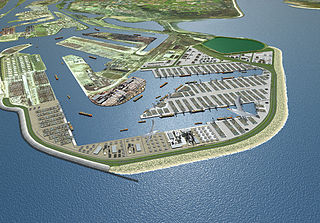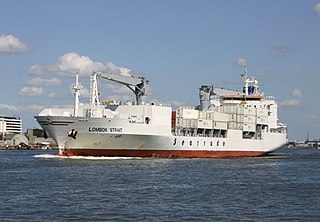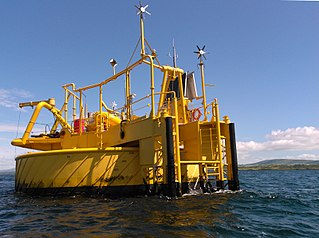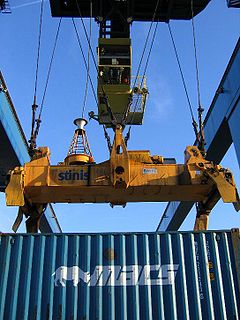 W
WCold ironing, or shore connection, shore-to-ship power (SSP) or alternative maritime power (AMP), is the process of providing shoreside electrical power to a ship at berth while its main and auxiliary engines are turned off. Cold ironing permits emergency equipment, refrigeration, cooling, heating, lighting and other equipment to receive continuous electrical power while the ship loads or unloads its cargo. Shorepower is a general term to describe supply of electric power to ships, small craft, aircraft and road vehicles while stationary.
 W
WA container chassis, also called intermodal chassis or skeletal trailer, is a type of semi-trailer designed to transport shipping containers. It is a wheeled metal frame onto which a container can be mounted for hauling over roads by a semi-tractor. Container chassis are important to intermodal freight transport.
 W
WA container crane is a type of large dockside gantry crane found at container terminals for loading and unloading intermodal containers from container ships.
 W
WA container ship is a cargo ship that carries all of its load in truck-size intermodal containers, in a technique called containerization. Container ships are a common means of commercial intermodal freight transport and now carry most seagoing non-bulk cargo.
 W
WA dock is the area of water between or next to one or a group of human-made structures that are involved in the handling of boats or ships or such structures themselves. The exact meaning varies among different variants of the English language.
 W
WA drayman was historically the driver of a dray, a low, flat-bed wagon without sides, pulled generally by horses or mules that were used to transport all kinds of goods.
 W
WA fireboat is a specialized watercraft with pumps and nozzles designed for fighting shoreline and shipboard fires. The first fireboats, dating to the late 18th century, were tugboats, retrofitted with firefighting equipment. Older designs derived from tugboats and modern fireboats more closely resembling seafaring ships can both be found in service today. Some departments would give their multi-purpose craft the title of "fireboat" also.
 W
WA gantry crane is a crane built atop a gantry, which is a structure used to straddle an object or workspace. They can range from enormous "full" gantry cranes, capable of lifting some of the heaviest loads in the world, to small shop cranes, used for tasks such as lifting automobile engines out of vehicles. They are also called portal cranes, the "portal" being the empty space straddled by the gantry.
 W
WA floating dock, floating harbour or wet dock is a dock alongside a tidal waterway which maintains a 'constant' level, despite the changing tides.
 W
WAn intermodal container, often called a shipping container, is a large standardized shipping container, designed and built for intermodal freight transport, meaning these containers can be used across different modes of transport – from ship to rail to truck – without unloading and reloading their cargo. Intermodal containers are primarily used to store and transport materials and products efficiently and securely in the global containerized intermodal freight transport system, but smaller numbers are in regional use as well. These containers are known under a number of names, such as simply container, cargo or freight container, ISO container, shipping, sea or ocean container, sea van or (Conex) box, container van, sea can or c can.
 W
WISO 6346 is an international standard covering the coding, identification and marking of intermodal (shipping) containers used within containerized intermodal freight transport. The standard establishes a visual identification system for every container that includes a unique serial number, the owner, a country code, a size, type and equipment category as well as any operational marks. The standard is managed by the International Container Bureau (BIC).
 W
WMaasvlakte 2 is a major civil engineering project in the Netherlands, constructing a new port and supporting infrastructure on reclaimed land adjoining the Maasvlakte. Approximately 2000 hectares will be reclaimed, behind a 4 km dike; approximately 1000 hectares will be used by ports related industries. It is an extension of the Port of Rotterdam.
 W
WA reach stacker is a vehicle used for handling intermodal cargo containers in small terminals or medium-sized ports. Reach stackers are able to transport a container short distances very quickly and pile them in various rows depending on its access.
 W
WA reefer ship is a refrigerated cargo ship typically used to transport perishable cargo, which require temperature-controlled handling, such as fruits, meat, vegetables, dairy products, and similar items.
 W
WA refrigerated container or reefer is an intermodal container used in intermodal freight transport that is capable of refrigeration for the transportation of temperature-sensitive, perishable cargo such as fruits, vegetables, meat, and other similar items.
 W
WA rubber tyred gantry crane is a mobile gantry crane used in intermodal operations to ground or stack containers. Inbound containers are stored for future pickup by drayage trucks, and outbound are stored for future loading onto vessels. RTGs typically straddle multiple lanes, with one lane reserved for container transfers. Advantages:its mobility gives a rubber tyred gantry crane wide appliance
 W
WA sidelifter is a specialised vehicle or semi-trailer used to hoist and transport ISO standard intermodal containers over longer distances.
 W
WA Single buoy mooring (SrM) is a loading buoy anchored offshore, that serves as a mooring point and interconnect for tankers loading or offloading gas or liquid products. SPMs are the link between geostatic subsea manifold connections and weathervaning tankers. They are capable of handling any tonnage ship, even very large crude carriers (VLCC) where no alternative facility is available.
 W
WA spreader is a device used for lifting containers and unitized cargo. The spreader is placed between the container and the lifting machine.
 W
WStowage plan for container ships or bay plan is the plan and method by which different types of container vessels are loaded with containers of specific standard sizes. The plans are used to maximize the economy of shipping and safety on board.
 W
WA straddle carrier or straddle truck is a freight-carrying vehicle that carries its load underneath by "straddling" it, rather than carrying it on top like a conventional truck. The advantage of the straddle carrier is its ability to load and unload without the assistance of cranes or forklifts. The lifting apparatus under the carrier is operated by the driver without any outside assistance and without leaving the driver's seat.
 W
WA Temperley transporter is an early form of overhead crane invented by John Ridley Temperley in 1892. They were manufactured by the Temperley Transporter Company of London.
 W
WA tugboat or tug is a marine vessel that manoeuvres other vessels by pushing or pulling them, with direct contact or a tow line. These boats typically tug ships that cannot move well on their own, such as those in crowded harbours or narrow canals, or those that cannot move at all, such as barges, disabled ships, log rafts, or oil platforms. They are powerful and durable for their size. Some are ocean-going, some are icebreakers or salvage tugs. Early models had steam engines, and modern ones have diesel engines. Many have deluge guns, which help in firefighting, especially in harbours.
 W
WThe twenty-foot equivalent unit is an inexact unit of cargo capacity, often used for container ships and container ports. It is based on the volume of a 20-foot-long (6.1 m) intermodal container, a standard-sized metal box which can be easily transferred between different modes of transportation, such as ships, trains, and trucks.
 W
WA twistlock and corner casting together form a standardized rotating connector for securing shipping containers. The primary uses are for locking a container into place on a container ship, semi-trailer or railway container train, and for lifting of the containers by container cranes and sidelifters.
 W
WA wharf, quay, or staith(e) is a structure on the shore of a harbour or on the bank of a river or canal where ships may dock to load and unload cargo or passengers. Such a structure includes one or more berths, and may also include piers, warehouses, or other facilities necessary for handling the ships. Wharves are often considered to be a series of docks at which boats are stationed.